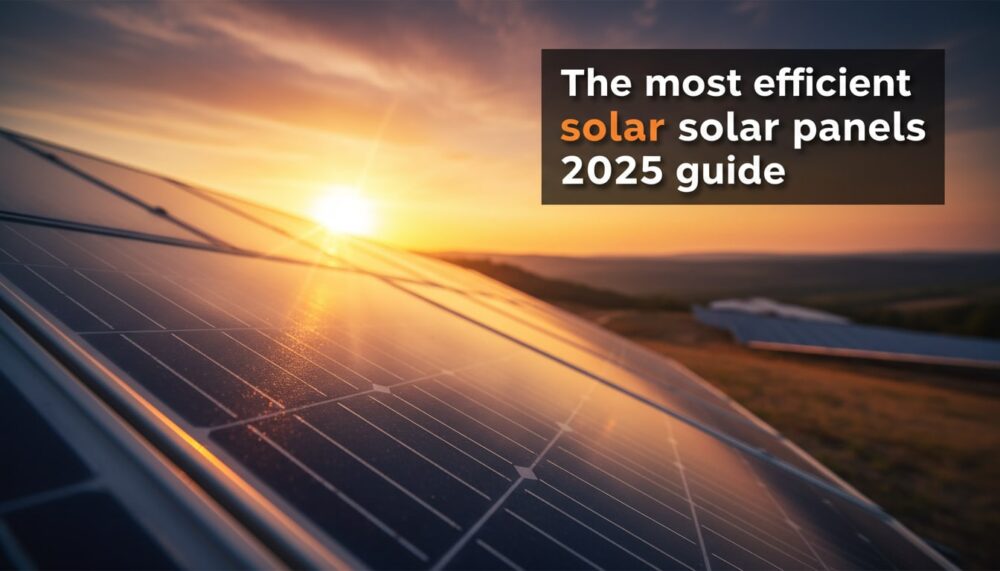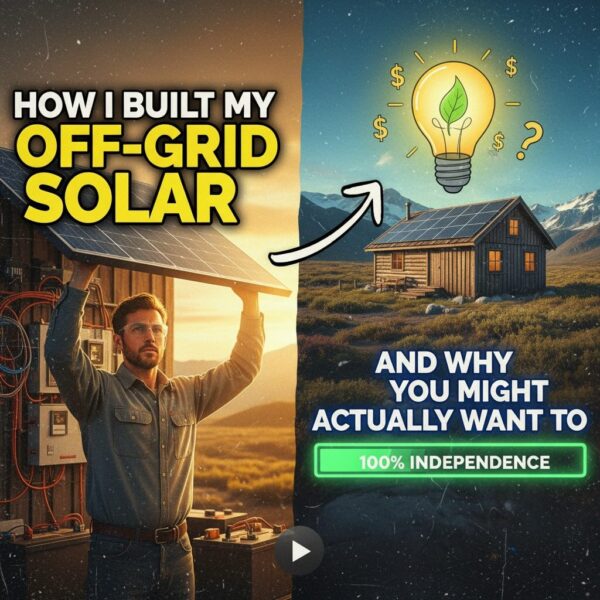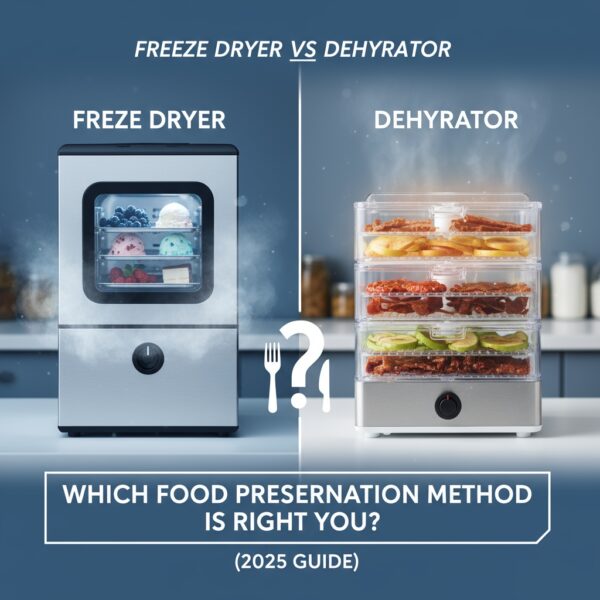Hey there, solar enthusiasts and energy-saving superstars!
Ready to dive into the electrifying world of solar panel efficiency? Well, hold onto your hats, ’cause we’re about to light up your life with some seriously juicy info! 💡
Did you know that in just a decade, average solar panel efficiency has skyrocketed from a measly 15% to a whopping 23%? That’s right, folks – we’re talking power output jumping from 250W to over 450W per panel! 🚀
But here’s the million-dollar question: What makes a solar panel efficient, and why should you care? Buckle up, buttercup, ’cause we’re about to embark on a sun-soaked adventure that’ll make you the smartest cookie on your block when it comes to solar power!
Let’s get this solar party started! 🎉
The ABCs of Solar Panel Efficiency: What’s the Big Deal?
Want the Best Prices on Solar in America Plus Legendary Customer Support? Click Here 👈
When diving into the world of solar energy, many newcomers find themselves puzzled by the concept of solar panel efficiency. It’s a crucial aspect that can make or break a solar investment, yet it’s often overlooked in the excitement of going green.
Solar panel efficiency is essentially the measure of how effectively a panel converts sunlight into electricity. It’s expressed as a percentage, with higher percentages indicating better performance. In today’s market, most quality panels boast efficiencies between 15-20%, with top-tier models pushing beyond 22%.
But why does this matter? Well, efficiency impacts several key factors:
-
- Power output: Higher efficiency means more electricity from the same amount of sunlight
-
- Space requirements: More efficient panels can produce the same power in a smaller area
-
- Cost-effectiveness: While high-efficiency panels may cost more upfront, they often provide better long-term value
-
- Environmental impact: Greater efficiency means a smaller carbon footprint per unit of energy produced
The efficiency of a solar panel depends on various elements, including cell technology, panel design, and materials used. Different types of solar cells, such as monocrystalline, polycrystalline, and the newer N-type cells, each offer different efficiency levels and cost considerations.
However, it’s important to note that the highest efficiency isn’t always the best choice for every situation. The ideal panel depends on specific energy needs, available space, and budget constraints. It’s about finding the right balance for each unique situation.
Meet the Superstars: Top 10 Most Efficient Solar Panels of 2025
In the rapidly evolving solar industry, keeping up with the latest and greatest can feel like chasing the sun. As of 2025, the efficiency race has reached new heights, with several manufacturers pushing the boundaries of what’s possible.
-
-
SunGold Power 560W Bifacial PERC Solar Panels: Bifacial technology captures sunlight from both sides for maximum power generation
2. SunGold Power 415W Monocrystalline Solar Panel: Impressive 21.25% module efficiency with sleek all-black design
3. Mission Solar 410W PERC Mono Solar Panel: Tier-1 USA Made quality with high efficiency PERC technology
4. Hysolis 410W Bifacial Solar Panel: 21% efficiency, up to 450W with rear-side gain
5. ShopSolar 390-550W Tier-1 Monocrystalline Panels: Choose your wattage from 390W to 550W with 25-year warranty
6. Mission Solar 395W PERC Solar Panel: Reliable PERC technology from a trusted USA manufacturer
7. SunGold Power 370W Monocrystalline: Solid 20.3% module efficiency with PERC half-cut cells
8. Rich Solar MEGA 335 PRO: Premium grid-tie or off-grid option for residential, commercial, and agricultural applications
9. Rich Solar MEGA 250 PRO: Premium 24V off-grid panel perfect for campers, tiny homes, and cabins
10. Rich Solar 200W Solar Panel: Compact 12V option with 19.98% efficiency and 25-year warranty
-
What’s remarkable is how close these top contenders are, with mere fractions of a percent separating them. But efficiency isn’t everything.
These panels utilize various technologies like N-type cells, Heterojunction (HJT), and TOPcon designs. Each has its strengths, whether it’s better performance in high temperatures or improved low-light efficiency.
Choosing Beyond Efficiency
When selecting a panel, consider factors beyond just efficiency:
-
- Warranty terms
-
- Degradation rates
-
- Manufacturer’s reputation
-
- Cost per watt
-
- Local availability and support
Cell Wars: The Battle for Supreme Efficiency
The heart of every solar panel is its cells, and the battle for efficiency supremacy is fought at this microscopic level. Over the years, cell technology has evolved dramatically, with each new innovation pushing the boundaries of what’s possible.
Traditional Cell Types
-
- Monocrystalline cells: Made from a single crystal structure, long been the gold standard for efficiency
-
- Polycrystalline cells: Slightly less efficient but popular due to lower production costs
The Rise of N-type Cells
N-type cells are doped with phosphorus instead of boron, resulting in:
-
- Higher efficiency
-
- Better performance in low-light conditions
-
- Lower degradation rates over time
Several variations of N-type cells are making waves:
- TOPCon (Tunnel Oxide Passivated Contact): Adds a thin oxide layer and a polysilicon layer to the rear of the cell
- HJT (Heterojunction): Combines crystalline silicon with amorphous silicon
- IBC (Interdigitated Back Contact): Moves all contacts to the rear of the cell
The Future: Perovskite Cells
Perovskite cells are generating excitement, achieving incredible efficiency rates in lab conditions, surpassing 30%. While stability and durability issues currently limit their commercial viability, many see Perovskite as the future of solar cell technology.
Size Matters: How Panel Dimensions Impact Efficiency
In the world of solar panels, size isn’t just about aesthetics – it plays a crucial role in efficiency and power output. Over the years, manufacturers have experimented with various sizes and configurations to maximize performance while balancing cost and practicality.
Traditional Sizes
-
- Residential: 60-cell configurations, about 65 inches by 39 inches
-
- Commercial: 72-cell panels, larger dimensions
Recent Trends
-
- Half-cut cells: Reduces internal resistance and improves performance
-
- Larger wafer sizes: Moved from 156mm to 166mm, 182mm, and even 210mm
-
- Increased power output: Some panels now reaching 600W+
Considerations When Choosing Panel Size
-
- Roof space and layout
-
- Ease of installation
-
- Transportation and handling
-
- Cost per watt
-
- Local building codes and weight restrictions
Remember, bigger isn’t always better. The ideal panel size depends on the specific needs of each installation.
Keeping It Cool: Temperature’s Impact on Solar Efficiency
One of the great ironies of solar energy is that the very thing panels need – sunlight – can also hinder their performance. As temperatures rise, solar panel efficiency tends to drop, a phenomenon known as the temperature coefficient.
Temperature Coefficients by Cell Type
-
- Traditional polycrystalline cells: -0.4% to -0.5% per °C
-
- Monocrystalline cells: -0.35% to -0.45% per °C
-
- N-type cells (TOPCon, HJT, IBC): -0.25% to -0.35% per °C
The lower the temperature coefficient, the better the panel performs in high-temperature conditions.
Strategies to Mitigate Temperature Effects
- Choose panels with low temperature coefficients
- Ensure proper ventilation behind the panels during installation
- Consider light-colored roofing materials to reduce heat absorption
- In very hot climates, look into active cooling solutions (for large commercial installations)
Beyond the Numbers: Real-World Factors Affecting Solar Panel Efficiency
While laboratory tests provide valuable information, real-world performance can be influenced by various external factors:
-
- Solar Irradiance: Varies by location, time of year, and weather conditions
-
- Shading: Even partial shading can significantly impact panel output
-
- Orientation and Tilt: Optimal angles vary depending on latitude
-
- Dirt and Dust: Can reduce efficiency by up to 5% or more
-
- Degradation: All panels lose some efficiency over time
-
- Inverter Efficiency: Impacts overall system performance
-
- Temperature Variations: Daily and seasonal fluctuations affect production
-
- Reflectance: Anti-reflective coatings help minimize light loss
-
- Spectral Response: Different cells respond differently to various light wavelengths
-
- System Design: Overall configuration impacts real-world efficiency
Show Me the Money: Is Higher Efficiency Worth the Investment?
When it comes to solar panels, the age-old question remains: is it worth shelling out extra cash for higher efficiency? The answer, like many things in life, is: it depends.
Cost Comparison
-
- Standard efficiency panels (15-17%): $0.70 – $1.00 per watt
-
- High-efficiency panels (20%+): $1.00 – $1.50 per watt
Long-term Savings Factors
- Energy Production: Higher efficiency panels produce more energy per square foot
- Installation Costs: Fewer panels mean lower installation costs
- Roof Space: High-efficiency panels can maximize energy production from limited area
- Durability: Many high-efficiency panels offer better durability and lower degradation rates
When to Splurge
-
- Limited roof space
-
- High electricity rates
-
- Long-term investment outlook
-
- Desire for cutting-edge technology
When to Save
-
- Ample roof space
-
- Tight budget
-
- Shorter-term investment outlook
-
- Moderate electricity rates
Ultimately, the decision comes down to individual circumstances. High-efficiency panels offer superior performance and potentially better long-term value, but they’re not always necessary or cost-effective for every situation. Careful consideration of current needs, future plans, and local factors will guide the best choice for each unique installation.
Remember, in the world of solar energy, it’s not just about being bright – it’s about being efficiently bright. Shine on, you crazy diamond! 💎☀️
Alright, solar superheroes, let’s bring it home! 🏠⚡
We’ve journeyed through the dazzling world of solar panel efficiency, from the nitty-gritty of cell tech to the real-world factors that can make or break your energy production.
Armed with this knowledge, you’re now ready to make an informed decision that’ll have your neighbors green with envy (and maybe a little curious about those shiny new panels on your roof)!
Remember, the most efficient solar panel isn’t just about the highest percentage – it’s about finding the perfect match for your unique needs, space, and budget. So go forth, harness that sweet, sweet sunlight, and bask in the glow of your solar-powered brilliance!
Ready to take the plunge into solar-powered awesomeness?
Don’t wait for the next blackout to hit…
Trust me, your future self (and your electricity bill) will thank you. ☀️💰





